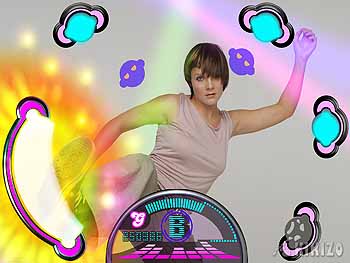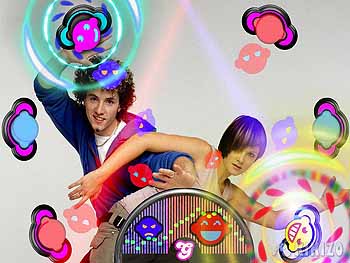EyeToy: Groove
Welcome to the world of EyeToy: Groove, a world of pain and humiliation! Depending on your spirit and booze intake before playing of course.
| Version PS2 | Developer SCEE London Studio | Publisher SCEE | Genre Action |
||||
Back in their stronger days Sega released the Dreameye, a digital video camera that could be used to chat with your friends online via the Dreamcast's Internet connection. Never being widely accepted and never seeing the light of day outside of Japan didn't do this groundbreaking piece of kit any favours and it soon went the same way as many of Sega's previous hardware. A few years later the SCEE R&D department came up with the idea of actually using the PS2's near redundant USB ports by adding a web camera with motion tracking software technology and the Eye Toy was born. It's debatable whether or not Sony took inspiration from the Dreameye to create the Eye Toy but if anyone can market this kind of thing and make it look cool to Joe Public, it's Sony.
Eye Toy: Play was released in the summer. It's better than Groove.
Quick fact: Almost two years ago the Eye Toy was featured on a BBC documentary that followed a group of teenagers as they tried to design and sell Eye Toy game ideas to Sony. Which just goes to show you that anyone can make one of these things... right?
Once you've set up your Eye Toy and waited for what feels like ten minutes you are presented with an amusing Eye Toy instructional movie depicting an elderly woman trying to play, which should give you all the information you need to set up the game. Although you can use the joy pad at anytime to manoeuvre the menus you should really be using your body to navigate the game just to get you in the spirit of coming events.
Obviously the music plays a major role in Groove so Sony have gone to the trouble of licensing twenty five chart dance hits for you to gyrate around to. While licensing songs is the done thing these days it's also helping to overshadow the work of many talented in-house game musicians, but then I doubt many thirteen-year-old girls will be interested in dancing to songs made by someone who doesn't have their own pop video. The majority of the songs in the game are the best examples of disposable pop around today, but don't despair just yet as you also have access to music dating back through the sixties, seventies, eighties and nineties! I suspect that once Groove is released in the US and Japan it will feature new tracks that will suit each region's taste, but I can't help but wish the European version had a few high-speed J-Pop tracks I could awkwardly shake along too.
Really though, if you don't like pop or disco you probably shouldn't be buying this game at all.
The gameplay itself isn't much different from Eye Toy: Play; you move your hands to hit or cover a designated area of screen except this time you do it in-time to music. As a dance game it isn't a patch on the erratic fun of most dance mat games as you never have to move your lower body but Eye Toy Groove's main selling point is that it gives you the ability to see yourself on your TV screen as you move, although some might say that's a bad thing. To save yourself from too much embarrassment you can play with friends in a whole host of team and competitive game modes including Team Sync where two players must attempt to dance in time with each other to match the given dance routine. There are also group tournaments and battle modes but if competition isn't your thing there are other areas such as the Chill Out Room and the Groove Bonus Bar. These modes offer you a chance to just dance and interact with the different screen effects while raking up points for the amount of effort you put into your moves.
For the more confident and talented dancers out there Sony added the Dance Move Maker, where you can create your own dance sequences, save them to your memory card and then challenge your mother (or whoever is willing to play) to match them.
The main problem I found with the gameplay of Groove and Eye Toy in general is that it's prone to errors due to poor light or poor accuracy, making some areas infuriating. An example would be in the harder modes and the speed required to beat them, it's to easy to flash your hand past a designated point on screen expecting it to register properly but if the Eye Toy isn't given enough time it won't even register your hand as being there. Without a doubt speed games are not what the Eye Toy does best.
Make of it what you will, I'm not a dancer and even if I were I think I would rather play DDR just for the reliability, better songs and movement involved. But as dancing games go Eye Toy is at least is individual. As more and more peripheral-dependant games come onto the scene maybe we'll see more family interaction around the world as we see in Japan at the moment, games can be a great family activity especially when it has something as unique as the Eye Toy involved. Pity about the lack of J-Pop though...
| ||||||||||||
|












 Satoru Iwata Video Interview - the late Nintendo president spoke with Kikizo in 2004 as 'Nintendo Revolution' loomed.
Satoru Iwata Video Interview - the late Nintendo president spoke with Kikizo in 2004 as 'Nintendo Revolution' loomed. Kaz Hirai Video Interview - the first of Kikizo's interviews with the man who went on to become global head of Sony.
Kaz Hirai Video Interview - the first of Kikizo's interviews with the man who went on to become global head of Sony. Ed Fries Video Interview - one of Xbox's founders discusses an epic journey from Excel to Xbox.
Ed Fries Video Interview - one of Xbox's founders discusses an epic journey from Excel to Xbox. Yu Suzuki, the Kikizo Interview - we spend time with one of gaming's most revered creators.
Yu Suzuki, the Kikizo Interview - we spend time with one of gaming's most revered creators. Tetris - The Making of an Icon: Alexey Pajitnov and Henk Rogers reveal the fascinating story behind Tetris
Tetris - The Making of an Icon: Alexey Pajitnov and Henk Rogers reveal the fascinating story behind Tetris Rare founders, Chris and Tim Stamper - their only interview? Genuinely 'rare' sit down with founders of the legendary studio.
Rare founders, Chris and Tim Stamper - their only interview? Genuinely 'rare' sit down with founders of the legendary studio. The History of First-Person Shooters - a retrospective, from Maze War to Modern Warfare
The History of First-Person Shooters - a retrospective, from Maze War to Modern Warfare